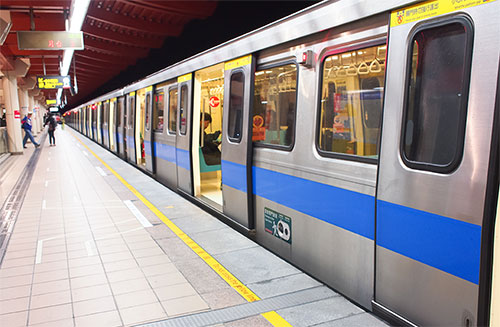
Developing an End to End Transportation Security Solution for Now and the Future
- By Dave Poulin
- Sep 11, 2013
 Accommodating the security needs of any public transportation system requires a well-designed, comprehensive surveillance and monitoring system that will provide a high degree of functionality. IP technology advancements and more cost-effective cameras are enabling interconnected, IP-based solutions, which provide transportation agencies with the visibility and image quality needed to ensure public safety, manage incidents, reduce risks and address liability claims on board trains and buses.
Accommodating the security needs of any public transportation system requires a well-designed, comprehensive surveillance and monitoring system that will provide a high degree of functionality. IP technology advancements and more cost-effective cameras are enabling interconnected, IP-based solutions, which provide transportation agencies with the visibility and image quality needed to ensure public safety, manage incidents, reduce risks and address liability claims on board trains and buses.
Today, transit agencies are increasingly relying on video surveillance cameras as their tool of choice to maintain safety, capture evidence and to fight crime and vandalism. The transportation market is predicted to significantly increase spending on video surveillance equipment over the next few years. From 2013-2017, it is anticipated that spending on surveillance equipment worldwide will grow at a compound annual growth rate of around 20% (1). Increased ridership and crime rates, along with ongoing budgetary concerns are just a few of the challenges agencies face today. To meet these challenges, most transit agencies in the United States are moving toward IP-based systems for their surveillance needs. IP-based systems are one of the most effective, flexible solutions enabling agencies to do more with less.
Benefits of IP Cameras
Increasingly sophisticated IP cameras provide a range of benefits for mass transit agencies. With improved image quality and advanced video analytics capabilities, agencies are able to improve overall safety for passengers and employees, and capture indisputable evidence when necessary. Surveillance in areas with large moving crowds requires a camera with powerful zoom to capture tiny details in a sea of people. A grainy image with dozens of people in frame will be of little help to authorities following a security incident in a crowded bus or train station.
IP cameras also aid in streamlining operations and management. An important feature to look for is easy integration and expansion. By investing in an IP camera system that integrates easily with new and existing video surveillance cameras and equipment, including legacy analog technology, agencies can save a significant amount of time and cost.
What makes these cameras especially vital in a mass transit setting is their remote monitoring and remote-control functionality. With millions of riders and numerous car, trains and buses to account for, it is impossible for security professionals to be in each of these places at all times. Remote monitoring solutions are incredibly valuable because they allow surveillance feeds to be broadcast in control rooms or on mobile devices, so security personnel on the go can access feeds from any location with the touch of a button. Security officials are able to monitor the camera feed via an IP network from any device; giving them access anywhere they need it. A tablet-based solution can allow officers the flexibility to monitor critical areas from any location and is an effective way to monitor in a mass transit setting with so many different moving parts.
IP Technology
As the demand for IP systems grows, so does the technology behind it. Advancements in technology are leading toward heightened intelligence in a variety of ways. Video analytics are continuing to improve, including technologies like face search that can be used to identify suspects in public areas. Face search allows security personnel to conduct high-speed searches of recorded video footage to locate a specific person based on a single reference face. This search can aid mass transit agencies in quickly finding a lost child or suspect at large, without having to spend hours sorting through endless video and a sea of faces. These recognition capabilities can also be used to recognize a face when it passes by a live camera. For example, mass transit locations could use this as a tool for allowing employees to gain access to an office or station, or alert them when a prohibited person attempts to enter a secure area.
Selecting Video Surveillance Solutions
With so many solutions available, it is important that agencies select the option that is the best fit for their needs. Mass transit, video surveillance solutions should be selected based on capabilities most appropriate for the agency. It is also important to invest in a solution that is easily expandable and reliable in order to ensure the highest possible return on investment. Investing money into these systems is not often easy for transit agencies due to tight budget restrictions, so it is important to get a quality product that will not only produce outstanding results, but will make the investment worthwhile.
Other important factors to take into account include the cameras ability to withstand the rugged environment on buses and trains. Dirt, grime and constant vibration can impact a camera’s image quality and longevity. Other considerations include vandal-resistant capabilities, indoor or outdoor use, impact resistance (especially important for in-vehicle cameras), as well as appearance. For safety considerations and to prevent vandalism, discreet, low-profile cameras can accurately capture video evidence without drawing unwanted attention.
While looking at all of the possibilities for a video surveillance solution, it is important to assess your agency’s unique security needs, then begin looking for purpose-built technology to address those challenges. It is equally important to have technology pieces that are fully expandable, rugged and reliable, and provide the image quality and clarity your agency needs to ensure your investment is worthwhile.
- http://beforeitsnews.com/business/2013/05/video-surveillance-spending-in-transportation-sector-on-rise-2514180.html